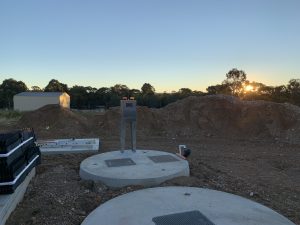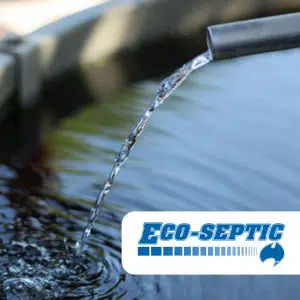Beyond the Tank: Unlocking the Potential of Treated Septic Water in Australia
Australia, renowned for its innovation and commitment to sustainability, is ushering in a new era in wastewater management. Beyond the conventional role of septic tanks, treated septic water is emerging as a valuable resource with a myriad of creative applications. In this exploration, we delve into the versatility of treated septic water, shining a spotlight on innovative uses such as irrigation and landscaping. Join us as we uncover the environmental benefits and business opportunities for Aerated Wastewater Treatment System (AWTS) providers, especially in regional communities.
Understanding Treated Septic Water: From Waste to Resource

Traditionally viewed as waste, septic tank effluent undergoes a rigorous treatment process in AWTS systems, transforming it into a high-quality treated water. This treated water, rich in nutrients and free from harmful contaminants, opens the door to innovative applications that go beyond the tank.
Sustainable Irrigation Practices:
One of the key applications of treated septic water is in sustainable irrigation. With Australia’s variable climate and periodic drought conditions, the ability to utilize treated water for agricultural irrigation presents a game-changing solution.
Unlocking Agricultural Potential:
Improved Soil Health: Treated septic water is a natural source of nutrients, promoting healthier soil and enhancing crop growth.
Water Conservation: By reusing treated water for irrigation, agricultural regions can reduce reliance on scarce freshwater resources.
Case Study: Orchard Oasis in Regional South Australia
The Smith family, owners of a fruit orchard in regional South Australia, implemented an AWTS system with a focus on water reuse. Treated septic water became a crucial resource for irrigating their orchard, leading to increased fruit yields and a more sustainable farming operation.
Lush Landscapes through Eco-Friendly Landscaping:
Treated septic water proves to be a boon for eco-friendly landscaping, offering a sustainable alternative to traditional irrigation methods. Homeowners, councils, and businesses can embrace water-wise landscaping practices that contribute to greener and more vibrant outdoor spaces.
Environmental Benefits of Treated Water Landscaping:
Reduced Demand on Freshwater: Using treated water for landscaping reduces the demand on freshwater sources, particularly in regions prone to water scarcity.
Biodiversity Support: Treated water encourages the growth of native plants and supports local biodiversity.
Local Impact: Beautifying Regional Parks
Regional councils across Australia are adopting treated water for landscaping in public parks. This not only enhances the aesthetic appeal of these spaces but also sets a precedent for sustainable water practices in the community.
Community Gardens and Sustainable Urban Agriculture:
Treated septic water opens up possibilities for community gardens and urban agriculture projects. By repurposing treated water for growing fruits, vegetables, and herbs, communities can foster self-sufficiency and strengthen local food systems.
Empowering Local Communities:
Access to Fresh Produce: Community gardens powered by treated water offer residents access to fresh, locally grown produce.
Educational Opportunities: Urban agriculture initiatives supported by treated water provide educational opportunities on sustainable living.
Success Story: Sydney Suburban Greening Project
In a suburban neighborhood in Sydney, an innovative project utilized treated water for community gardens. This initiative not only transformed unused spaces into thriving green areas but also brought neighbors together in a shared commitment to sustainability.
Business Opportunities for AWTS Providers:
The emergence of creative uses for treated septic water also presents exciting business opportunities for AWTS providers. Collaborating with local businesses, farmers, and councils can lead to mutually beneficial partnerships.
AWTS Business Growth Strategies:
Educational Outreach: AWTS providers can engage in educational programs to raise awareness about the benefits of treated water and its diverse applications.
Customized Solutions: Offering tailored AWTS solutions that cater to the specific needs of businesses and communities enhances the market presence of AWTS providers.
Case Study: Regional AWTS Business Expansion
A regional AWTS provider in Victoria collaborated with local farmers to implement custom-treated water solutions for irrigation. This not only contributed to increased agricultural productivity but also positioned the AWTS provider as a leader in sustainable water management.
Environmental Stewardship in Regional Australia:
Adopting innovative uses for treated septic water aligns with the principles of environmental stewardship, especially in regional Australia where natural resources are valued. By showcasing the environmental benefits, communities can take pride in contributing to a more sustainable future.
Promoting Regional Sustainability:
Local Resilience: Using treated water locally fosters resilience in regional communities, reducing dependence on external resources.
Preserving Ecosystems: Treated water applications contribute to the preservation of regional ecosystems, ensuring a harmonious coexistence with nature.
Community Spotlight: Environmental Awards in Regional Queensland
A regional community in Queensland received environmental awards for their innovative use of treated water in local landscaping projects. This recognition not only celebrated their efforts but also inspired neighboring communities to explore similar initiatives.
Treated Water, Untapped Potential for Regional Prosperity
As we look beyond the tank, the untapped potential of treated septic water emerges as a catalyst for positive change in regional Australia. The innovative applications discussed, from sustainable irrigation to eco-friendly landscaping, not only benefit the environment but also create opportunities for businesses and communities.
For regional consumers, this marks a shift from viewing septic water as waste to recognizing it as a valuable resource that can contribute to the prosperity and sustainability of their communities. By embracing these creative uses for treated septic water, regional Australians play a pivotal role in shaping a future where every drop counts and where sustainable water practices become integral to regional prosperity. As the landscape evolves beyond the tank, the potential for regional growth and environmental stewardship becomes boundless.
For a Free Quote and Sizing on all Septic Tanks Made in Australia call the team at Eco-Septic on 1800 808 135
Related Posts
- Why is the Treatment of Wastewater Important?
- Choosing the Right Septic Tank Size for Your Sydney Property
- How do aerated wastewater treatment systems work
- Why would you need a sewage treatment plant?
- Reinventing the Septic Tank for the 21st Century
- How do I collect rainwater?
- Understanding Wastewater Production and its Impact on Septic Systems
- The Benefits of Using a Pump Well for a Septic Tank





